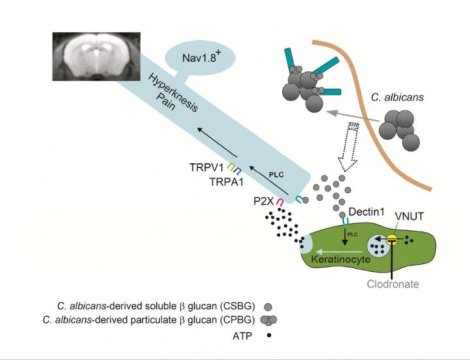[ad_1]
Candida albicans infection (candidiasis) can cause skin, genital, or oral pain. Many studies have attempted to understand the source of pain in candidiasis; none have provided a clear explanation, until now.
In a new study published in iScience, “The ATP transporter VNUT mediates induction of Dectin-1-triggered Candida nociception,” a research team led by experts from Osaka University investigated the role of Dectin-1, a β-glucan receptor, in the sensing of fungal infection. They found that Dectin-1 was critical for the onset of pain related to fungal infection.
Candidiasis is an infection that causes skin or oral pain in many individuals. It frequently occurs in patients who are immunocompromised or have poorly controlled diabetes. Additionally, it affects a large proportion of women, causing vulvovaginal pain in approximately 75% of women worldwide at some point in their lifetimes, and causing severe nipple pain in some lactating women. Despite a variety of efforts to understand the mechanisms of such severe pain in candidiasis, the primary effective treatment has been resolution of the infection, which does not occur quickly, particularly in immunocompromised patients.
“We previously found that fungal infection stimulated pain through β-glucan nociceptors, such as Dectin-1, but we did not know whether these receptors directly interacted with Candida fungi,” says Kenta Maruyama, lead author on the study. “We were excited to find that β-glucan-induced pain is abolished in Dectin-1 and TRPV1/TRPA1 deficient mice.”
In the study, the researchers found that β-glucan stimulates nociceptors via the Dectin-1-PLC axis, activating neurons. Notably, components secreted from fungal cells caused the same activation of nociceptors.
“Our analyses revealed that β-glucan-induced allodynia (pain) is dependent on extracellular ATP and VNUT, an ATP transporter,” says Maruyama. “We found that the VNUT inhibitor clodronate can be used to treat β-glucan-induced allodynia.”
In addition to identifying a mechanism to block fungal pain in mice, the researchers identified a new signaling pathway, from Dectin-1 to TRP channels in the generation of pain and found that the ultimate activation of such pain was critical for the resolution of fungal inflammation.
Candidiasis is a painful infection that affects a large number of individuals, and may cause extreme pain in some cases. This study has shown that the Dectin-1 pathway could be an important new target for treatment of candidiasis, and that clodronate may provide a readily available therapy that may be quickly used in clinical treatment of severe fungal pain.
Story Source:
Materials provided by Osaka University. Note: Content may be edited for style and length.
[ad_2]















